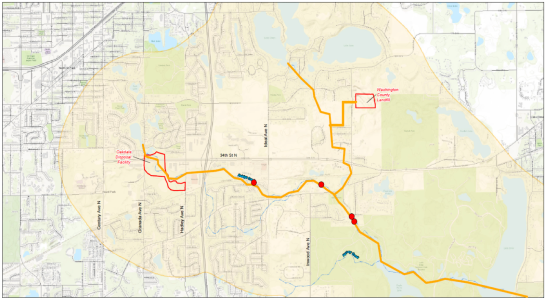There are two types of foam:
- Foam on lakes, streams, and creeks
- Firefighting foam
Foam on lakes, streams, and creeks
Most foam observed in lakes or streams is naturally occurring, and not an indicator of pollution. Foam is created when air mixes with natural organic compounds, such as decomposing plant material. The mixing or agitation in lakes is commonly caused by wind and wave action; in streams, it may result from water flowing through rapids or over a dam. Natural foam tends to be off-white, tan, or brown and have a fishy odor. Foam caused by detergents will often be white and may have a perfume smell.
PFAS-containing foam
PFAS can also sometimes cause foaming on surface waters. In Minnesota, foam containing PFAS has been found in surface water pathways in the east metropolitan area of the Twin Cities which is a known area of PFAS contamination in groundwater and surface waters that was traced back to four landfills or dump sites.
As part of the 2018 3M Settlement, the MPCA is looking at how a flood-control project from the late 1980s, known as Project 1007, may be contributing to the movement of PFAS in the east metro area.
During a surface water investigation in the Project 1007 area, foam was observed on Raleigh Creek in Oakdale. Because this area is located near two of the disposal sites, the foam samples taken from Raleigh Creek had elevated levels of PFAS. Surface water samples collected in the same areas showed much lower levels of PFAS.
The map on the right depicts the foam sampling locations on Raleigh Creek.
Additional monitoring and sampling is taking place and will continue to learn more about PFAS impacts in surface water, soil, and groundwater.
Other locations
PFAS-containing foam was also encountered on Battle Creek in St. Paul. Battle Creek is being investigated further through MPCA’s superfund site assessment program and is not part of Project 1007.
The map on the right depicts where the initial foam sample was taken on Battle Creek in St. Paul.
For more information, visit the Minnesota Pollution Control Agency website.
If in doubt, stay out.
PFAS-containing foam on surface water does not pose a risk to human health if skin contact with foam is minor and infrequent. The Minnesota Department of Health (MDH) recommends:
- People and pets should avoid contact with foam on surface waters in this area.
- Wash skin that has come into contact with PFAS-containing foam with soap and water.

